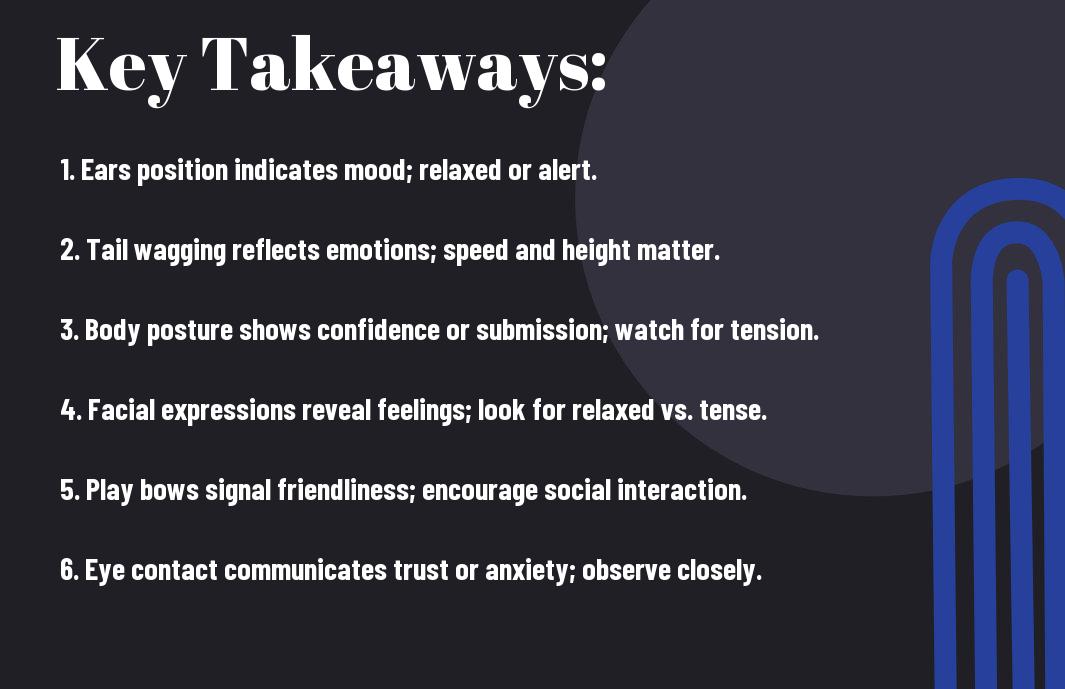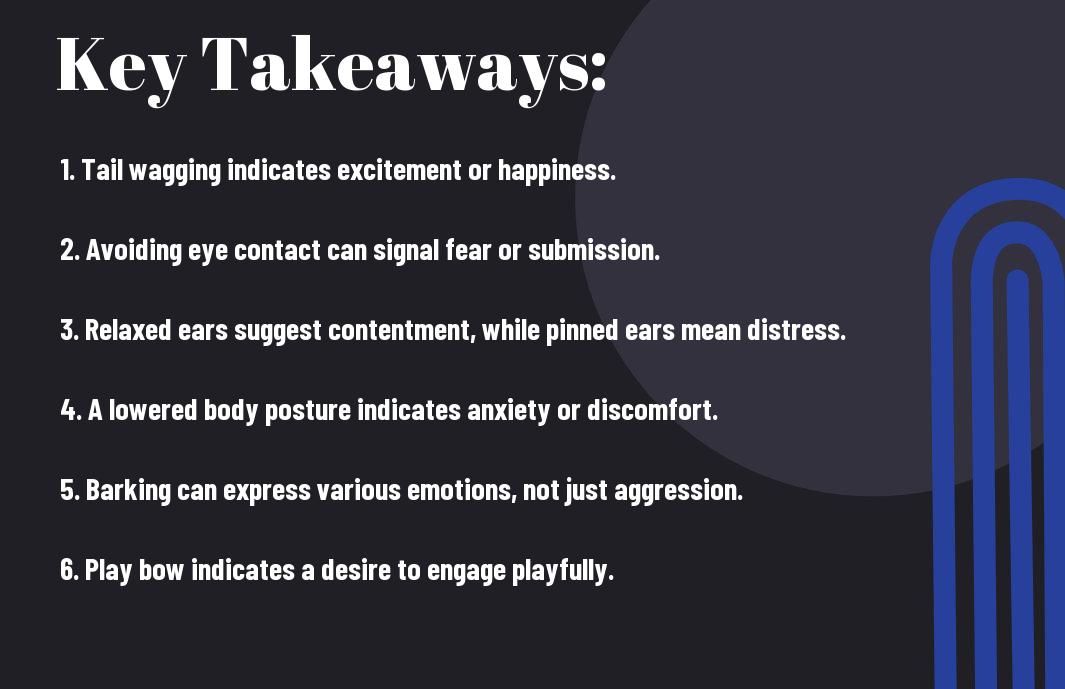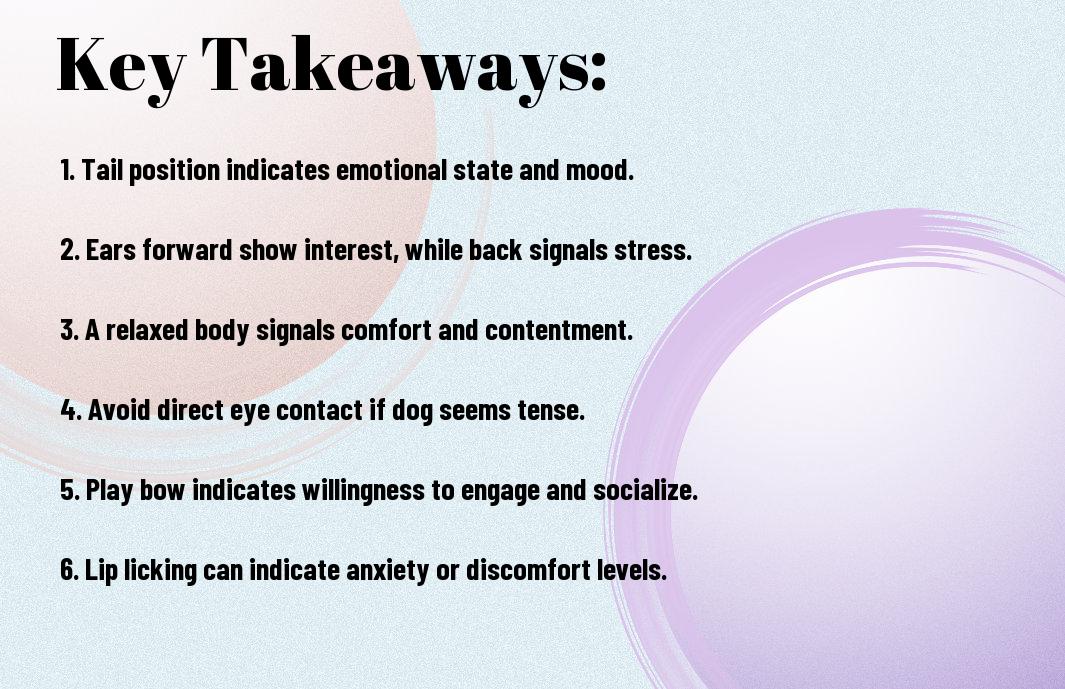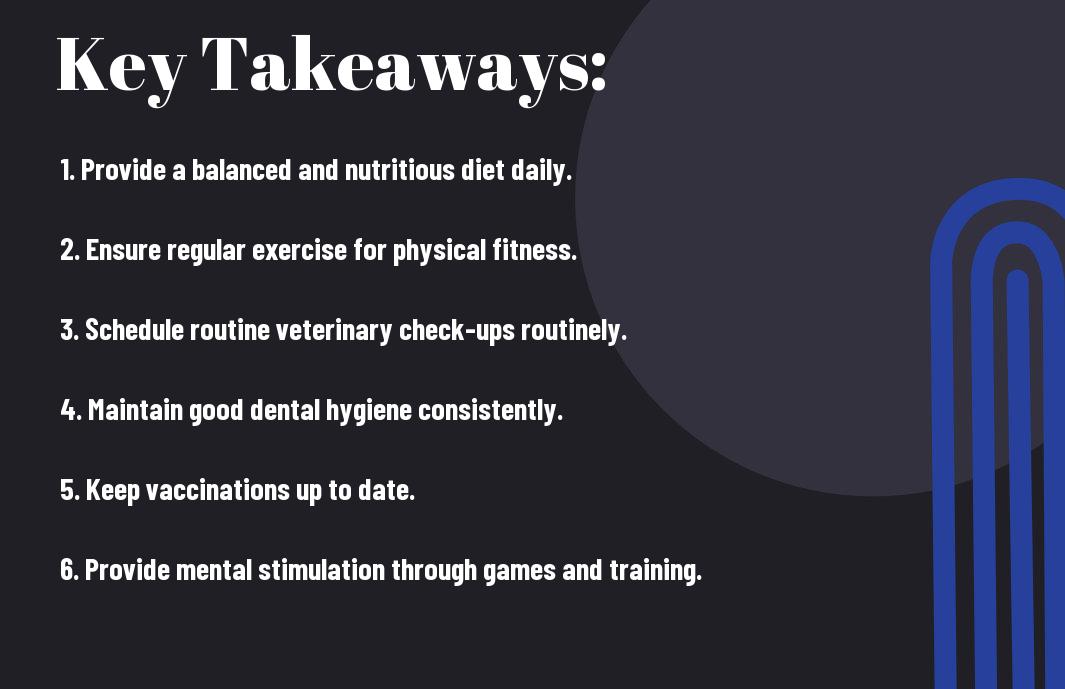It’s important to understand your dog’s body language to enhance your communication and strengthen your bond. By observing their movements, facial expressions, and posture, you can gain insights into their feelings and intentions. This knowledge will help you respond appropriately to your dog’s needs, whether they’re anxious, excited, or relaxed. In this post, you will learn how to interpret various signals your dog displays, enabling you to foster a harmonious relationship with your furry companion.
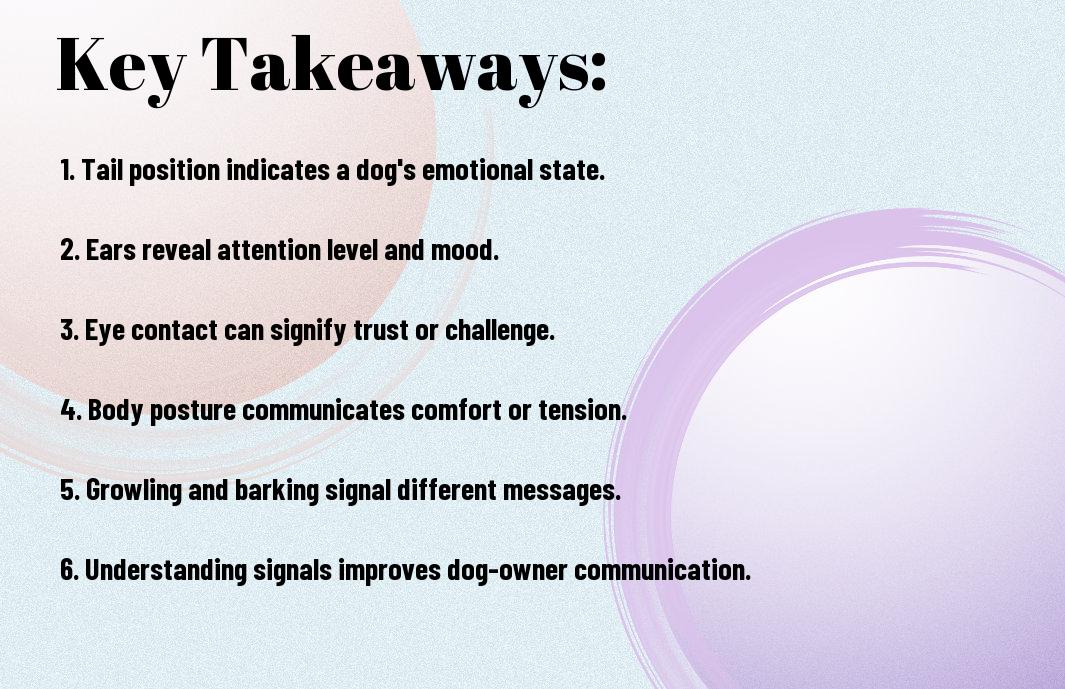

The Importance of Understanding Canine Body Language
The ability to interpret your dog’s body language is fundamental to creating a strong bond between you and your pet. By understanding the subtle signals and cues your dog exhibits, you can address their needs more effectively, respond to their emotions, and ultimately prevent misunderstandings that can lead to behavioral issues. Awareness of canine body language will enrich your experience with your dog, fostering a deeper connection and improving communication between the two of you.
The Role of Non-Verbal Cues
Across numerous interactions throughout your dog’s life, non-verbal cues serve as primary means of communication. Your dog relies on a combination of body posture, tail position, ear and facial expressions, and even vocalizations to convey their feelings and intentions. Learning to recognize these cues enables you to respond appropriately and maintain a harmonious relationship, enhancing both your dog’s well-being and your shared experiences.
The Canine Communication System
Language is multifaceted, and dogs use a complex set of signals to interact with each other and with humans. Their communication system is highly nuanced and includes not only visible body language but also vocalizations that can indicate various emotions such as excitement, anxiety, or aggression. Understanding this system lets you better perceive what your dog is trying to communicate, allowing for more effective and empathetic responses.
Plus, recognizing these signals can help you interpret your dog’s state of mind in different situations. For instance, a wagging tail isn’t always a sign of happiness; context is key. A dog may wag its tail while feeling anxious, which could indicate a need for comfort or space. By being attuned to these nuances, you can provide the kind of support or intervention your dog needs when faced with various situations, ultimately leading to a more well-adjusted pet.
Enhancing Human-Dog Relationships
By understanding canine body language, you strengthen the foundation of trust and companionship you share with your dog. When you respond appropriately to your dog’s signals, it fosters a sense of security, making them feel understood and valued in your relationship. This mutual understanding is imperative for creating a harmonious home environment, where both you and your dog feel comfortable and relaxed.
Systematically paying attention to these subtleties not only boosts your dog’s confidence but also transforms how they interact with the world around them. As you become more attuned to your dog’s needs and emotions, you’ll find that your bond deepens, leading to a more rewarding and enriched life together. Embracing this understanding opens the door to a more fulfilling relationship where communication flows effortlessly, enhancing the joy you both experience in each other’s company.

Basic Canine Body Language
It’s vital to understand your dog’s body language, as it greatly influences how you communicate with your furry friend. Dogs use various forms of non-verbal communication to express their feelings, desires, and even discomfort. By learning to interpret these signals, you enhance the bond between you and your dog, ensuring a more harmonious relationship.
Tail Position and Movement
With each wag or position of your dog’s tail, a different message is conveyed. A tail held high can indicate confidence and excitement, while a low or tucked tail may suggest fear or submission. Additionally, the speed of the wag can significantly alter its meaning; a slow wag often implies uncertainty, while a fast, vigorous wag may indicate joy or eagerness to interact.
Understanding how tail movement changes in different contexts can help you navigate your dog’s emotions. For instance, if your dog approaches you with a wagging tail but appears tense, there may be underlying anxiety. Being attuned to these subtle cues allows you to respond appropriately, providing your dog with reassurance when needed.
Ear Position and Movement
Tail position is just one aspect of canine body language; your dog’s ears also tell a compelling story about their state of mind. Ears that are perked up and facing forward typically indicate curiosity or attentiveness, while ears that are pinned back may reflect fear or submission. The way your dog moves their ears can provide insight into what they are focusing on at the moment.
As you observe your dog, you’ll notice that the position and movement of their ears can change quickly in various situations. An attentive ear position while playing may suggest your dog is excited and engaged, while droopy ears during a vet visit might indicate anxiety or discomfort. Paying attention to these signals helps you respond to your dog’s feelings more empathetically.
For instance, a dog with ears that are slightly angled back but not completely flat may still be feeling uncertain yet curious about their surroundings. This indicates they might need a gentler approach or more time to adjust to a new environment or situation.
Facial Expressions
Behind your dog’s expressive eyes and mouth lies a wealth of information about their emotions. Facial expressions can reveal a range of feelings, from happiness and playfulness to fear and aggression. You might notice that a relaxed face, with a slightly open mouth and a soft gaze, signifies contentment. Conversely, a stiff jaw and narrowed eyes may indicate tension or a more serious state of mind.
Your dog’s facial expressions are vital in understanding their emotional landscape. Recognizing when your dog appears playful versus anxious helps you adjust your interactions accordingly. The richness of their expressiveness can convey a lot more than you might initially perceive, offering a deeper glimpse into how they feel at any given moment.
Plus, a dog’s relaxed face can greatly enhance your interactions; this playful demeanor often encourages more engagement, whether that means playing fetch or simply lounging together. By observing and understanding these subtle facial cues, you establish a more meaningful dialogue with your dog, reinforcing the bond between you both.
Positive Body Language Signals
Unlike humans, dogs have a unique way of expressing their feelings through body language. Understanding these signals allows you to communicate effectively with your furry friend, enhancing the bond you share. When your dog is exhibiting positive body language, they are usually signaling comfort, joy, and trust, making it important for you to recognize and respond to these signals appropriately.
Playfulness and its Indicators
Indicators that your dog is feeling playful include the classic “play bow,” where your dog lowers their front legs while keeping their rear end elevated. Another common sign is a wagging tail, often held high and moving rapidly. You’ll also notice a relaxed posture, with your dog appearing bouncy or energetic, ready to engage in some fun activities with you.
Relaxed Posture and Behavior
Beside playfulness, relaxed posture and behavior are significant indicators of a contented dog. When your dog lies down with a loose body, soft facial features, and ears in a neutral position, it shows they are comfortable in their environment. A relaxed tail, often left hanging and swaying gently, further indicates that your dog feels secure and happy.
Plus, you may observe your dog occasionally yawning or stretching when they are relaxed. These behaviors are not only signs of contentment but also indicate a willingness to engage with you or explore their surroundings at their own pace. A calm and relaxed dog is one that feels safe, making it easier for you to bond and interact positively.
Approaching Behavior
One notable positive behavior is when your dog approaches you confidently. They may walk towards you with a wagging tail held in a neutral position, showing they are excited to connect. Unlike anxious behavior, a confident approach is often characterized by an upright stance, open mouth, and soft eyes. This indicates they are feeling happy and comfortable in your presence, ready to share positive moments with you.
Playfulness is further exemplified by your dog’s eagerness to engage in activities or exhibit curiosity as they come closer to you. Your dog’s approach can also signify their trust in you, knowing they can rely on your guidance and protection. Observing these behaviors helps you understand your dog’s emotional state, facilitating enhanced communication and a more profound connection.
Negative Body Language Signals
To effectively communicate with your dog, it’s important to be aware of the negative body language signals they may display. These signals often indicate discomfort, fear, or aggression, and understanding them can help you respond appropriately to your pet’s needs. Recognizing these signs early allows you to take action before a situation escalates, promoting a harmonious relationship between you and your furry friend.
Signs of Fear and Anxiety
By observing your dog’s posture, ears, and tail, you can detect signs of fear and anxiety. A dog that is fearful might crouch low to the ground, tuck their tail, or flatten their ears against their head. They may also avoid eye contact or try to hide, seeking refuge in a corner or behind you. If you notice your dog displaying these behaviors, it’s important to create a calm environment and reassure them that they are safe.
When your dog exhibits signs of anxiety, such as pacing, whining, or excessive licking, it’s crucial to identify the trigger causing their distress. Common causes include loud noises, unfamiliar environments, or the presence of other animals. Addressing these triggers can help mitigate your dog’s anxiety and promote their overall well-being.
Signs of Aggression
Signs of aggression in dogs can manifest in various ways, and recognizing these behaviors is vital for your safety and that of others. When your dog feels threatened or challenged, they may display behaviors like growling, baring their teeth, or raising their hackles. These signs indicate that your dog is uncomfortable and may be preparing to defend themselves. Understanding these signals allows you to take preventative measures to avoid confrontation.
Understanding aggression can also help you navigate social situations with your dog, especially around unfamiliar people or animals. If your dog shows aggressive behaviors, it’s important to address the underlying issues through training and socialization. A professional dog trainer can work with you and your dog to implement strategies to manage aggression and foster a more relaxed and confident companion.
Warning Signals: Growling and Snapping
Negative body language in dogs often includes warning signals like growling and snapping. These behaviors are your dog’s way of communicating discomfort or a desire to retreat from a situation. Growling can serve as a warning, indicating that your dog is feeling threatened or irritated. Likewise, snapping is a more extreme reaction that could signify an imminent bite if the situation does not change. It’s critical to take these warning signs seriously and take appropriate action to ensure the safety of your dog and those around them.
Language is a powerful tool of communication, not only for humans but also for dogs. When your dog growls or snaps, it’s important that you interpret what they are trying to convey. This understanding allows you to adjust your interactions and environment accordingly, ensuring that your dog feels secure and understood in various situations.
Contextual Factors in Canine Communication
Many pet owners underestimate the significance of context when interpreting their dog’s body language. Understanding your dog’s signals requires considering various factors that influence their behavior. Here are some vital contextual factors to keep in mind:
- Environment
- Interactions with other dogs
- Your dog’s history or past experiences
- Current emotional state
- Physical condition or health issues
Thou shall not overlook these elements, as they can dramatically alter the meaning behind your dog’s actions.
Environmental Influences
By focusing on environmental influences, you can gain valuable insights into your dog’s body language. The location, time of day, and even weather conditions can impact how your dog reacts in specific situations. For instance, a dog may exhibit different behavior in a busy park compared to the comfort of their home. Similarly, noise levels can trigger anxiety or excitement, affecting your dog’s responses and expressions.
As you observe your dog, consider how these environmental factors shape their feelings. A relaxed and familiar setting may encourage more playful behavior, while a thrilling new experience could lead to heightened alertness or stress. Understanding these dynamics will enhance your communication with your canine companion.
Interactions with Other Dogs
Other dogs play a significant role in shaping your pet’s behavior, as their reactions can either encourage or discourage certain actions. When your dog interacts with others, pay attention to their body language as it communicates feelings about their playmate. For instance, a wagging tail does not always mean friendliness; it can also denote excitement or even nervousness depending on the context of the encounter.
Even subtle signals, such as ear positions and facial expressions, are pivotal when assessing your dog’s comfort level in a social situation. Stiff body language may indicate tension, while loose posture can suggest relaxed playfulness. Therefore, understanding your dog’s interactions with fellow canines is integral to their well-being.
Human Influence on Dog Behavior
By acknowledging human influence on dog behavior, you can foster a more understanding relationship with your pet. Your actions, tone of voice, and even your body language send strong signals to your dog. Consistency in training and positive reinforcement helps develop trust, while unpredictability can lead to confusion and anxiety. Dogs are astute observers and often pick up on their owner’s emotional states, which can affect their own behavior.
Consequently, it is vital to maintain a calm and confident demeanor when communicating with your dog. When you display negative emotions such as frustration or fear, your dog may mirror these feelings, leading to behavioral issues over time. Understanding your influence on your dog’s body language and communication will enable both you and your pet to enjoy a healthier, more harmonious relationship.
Training Your Dog to Understand Human Signals
Now, as you commence on the journey of training your dog to comprehend your signals, it’s imperative to appreciate the nuances of effective communication. Your dog relies on a combination of visual, auditory, and tactile cues to understand what you want from them. By being mindful of how you interact with your canine companion, you can create a solid foundation for clear and effective communication.
The Importance of Consistency
Your approach to training should emphasize consistency in both signals and responses. Dogs thrive on routine, and if you use different commands or gestures for the same action, it can lead to confusion. For instance, if you use the word “sit” one day and “down” the next for the same command, your dog may struggle to pick up on what you want. Stick to specific commands and relevant gestures to help your dog build a reliable understanding of your expectations.
Your consistency should extend to your reactions as well. If your dog obeys a command, always provide positive feedback, but if they don’t, avoid scolding. Instead, guide them gently back to the desired action. By maintaining uniformity in your commands and reactions, your dog will begin to grasp what each signal means, fostering a smoother training experience.
Using Positive Reinforcement
Around the world of dog training, positive reinforcement stands out as one of the most effective techniques. This approach involves rewarding your dog with treats, praise, or playtime when they successfully follow your commands. When your pup associates following your signals with positive outcomes, they become more motivated to respond correctly in the future. This builds trust and encourages a stronger bond between you and your dog.
In fact, using positive reinforcement can significantly enhance your dog’s willingness to learn and participate. Instead of viewing training as a chore, your dog begins to see it as a fun activity filled with rewards. The joy of receiving a treat or praise upon complying fosters a positive learning environment, enhancing the likelihood that the behavior will be repeated. As you train, ensure you offer timely rewards—immediately after your dog performs the desired action—to strengthen the connection between their behavior and the reward.
Teaching Basic Commands and Cues
Across the training process, instilling basic commands and cues is vital for effective communication. Start with fundamental commands like “sit,” “stay,” and “come.” These commands not only help manage your dog’s behavior but also lay the groundwork for more advanced training. When your dog becomes proficient in these imperatives, you will find it much easier to communicate other complex signals and behaviors as they build confidence in responding to you.
But establishing a solid grasp of these commands requires patience and repetition. Use engaging methods such as incorporating fun games or interactive training sessions to hold your dog’s attention. Consistently reinforce these commands in various environments, ensuring that your dog understands that they must respond regardless of distractions. This approach will help solidify their understanding and enhance their ability to comprehend your signals fully.
To Wrap Up
As a reminder, understanding canine body language is an vital skill that can significantly enhance the bond between you and your dog. By recognizing the signals your dog uses to communicate its feelings, you can respond more effectively to its needs and emotions. This not only promotes a more harmonious relationship but also helps in managing behavior and reducing stress for both you and your pet. Engaging with your dog through proper communication fosters a trusting and loving environment, ensuring that your dog feels safe and understood in your presence.
Equipping yourself with knowledge about your dog’s body language empowers you to be a better dog owner. Observing the nuances of your dog’s posture, facial expressions, and tail movements will enable you to interpret its mood and intent accurately. By applying these insights in your daily interactions, you will cultivate a deeper connection with your furry friend, leading to a happier and more fulfilling life together. So take the time to observe, learn, and connect—your dog will undoubtedly appreciate the effort you make in understanding its unique language.
Q: Why is understanding canine body language important for dog owners?
A: Understanding canine body language is necessary for dog owners because it allows for better communication and strengthens the bond between the dog and its owner. By recognizing and interpreting a dog’s signals, such as tail wagging, ear position, and facial expressions, owners can identify their pet’s emotional state and respond appropriately. This understanding can help prevent misinterpretations that may lead to fear, anxiety, or aggressive behavior, ultimately creating a more harmonious relationship and ensuring the dog’s well-being.
Q: What are some common signs of a relaxed dog?
A: A relaxed dog typically exhibits a variety of calming signals that indicate they are comfortable in their environment. Look for a loose, wagging tail held at a natural level, relaxed ears that are not pinned back or perked up, and a soft expression without tense muscles around the face. The dog may also approach you with a loose body posture, or lie down with their paws stretched out. Understanding these signs can help owners gauge when their dog is at ease and enjoying their surroundings.
Q: How can I tell if my dog is anxious or stressed?
A: An anxious or stressed dog may display several tell-tale signs that include avoidance behaviors, such as turning away or hiding, as well as body language that signals discomfort. Common indicators include tensed muscles, a tucked tail, ears pinned back against the head, and flattened body posture. Additionally, an anxious dog may bark excessively, chew on objects, or exhibit pacing behavior. Being able to identify these signals enables owners to take appropriate action to alleviate the dog’s stress and create a more comfortable environment for them.
